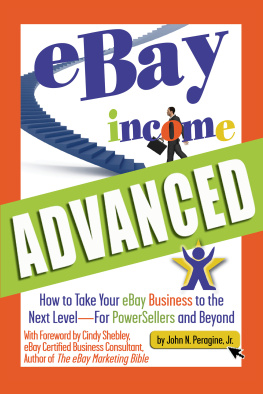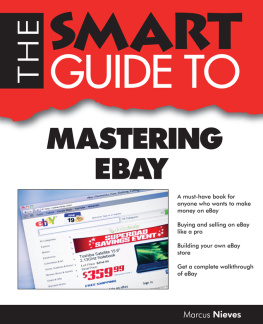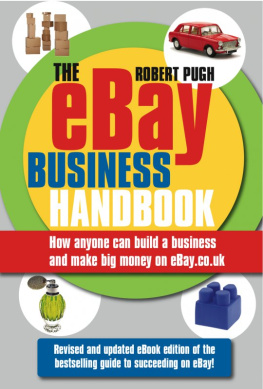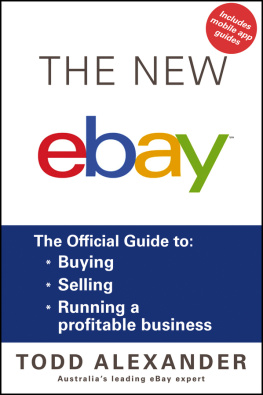Book Presentation The eBay Phenomenon by David Bunnell
About the Author
DAVID BUNNELL is CEO and Editor of Upside Media, publishers of Upside Magazine . He is also the founder of PC Magazine, PC World, Macworld Magazine, Publish Magazine and Macintosh Today, as well as the developer of a number of other media products including the Macworld Expo. Mr. Bunnell is also the author of Making the Cisco Connection .
Important Note About This Ebook
This is a summary and not a critique or a review of the book. It does not offer judgment or opinion on the content of the book. This summary may not be organized chapter-wise but is an overview of the main ideas, viewpoints and arguments from the book as a whole. This means that the organization of this summary is not a representation of the book.
Summary of The eBay Phenomenon (David Bunnell)
Section 1. The Early Days
eBay was founded in September 1995 as a part time business by Pierre Omidyar and Jeff Skoll. Silicon Valley legend has it that Omidyar was inspired to start the business by the fact his girlfriend collected Pez dispensers, but the reality of the situation was actually a little more mundane.
I had been thinking about how to create an efficient marketplace a level playing field, where everyone had access to the same information and could compete on the same terms as anyone else. Not just a site where big corporations sold stuff to consumers and bombarded them with ads, but rather one where people traded with each other. I thought if you could bring enough people together and let them pay whatever they thought something was worth, real values could be realized and it could ultimately be a fairer system a win-win for buyers and sellers.
Pierre Omidyar
Omidyar had earned an undergraduate degree in computer science from Tufts University. Born in 1968, he had worked for Claris (a software subsidiary of Apple Computer) and General Magic before cofounding Ink Development Corporation, one of the pioneers of online retailing.
Skoll, by contrast, had an MBA from Stanford University. The same age as Omidyar, Skoll had worked for a number of solid business companies, including Knight-Ridders online information venture. Skoll could provide the know-how and business sense to structure fees and business systems. He could take Omidyars concept and build a business around it.
The two young entrepreneurs launched their business operating from Omidyars apartment. Their business equipment consisted of a filing cabinet, an old school desk, a laptop computer and an Internet Service Provider(ISP) account. Within six months, they were actually generating so much traffic their ISP closed their account, and the two partners were forced to buy their own server. To cover their costs, they decided to charge 25-cents for each listing on their auction site.
People seemed happy to pay for the service, except I was so busy keeping the site going, I couldnt even get to the mail and open the checks that were piling up. Thats when I realized my little hobby experiment had taken on a life of its own.
Pierre Omidyar
In May 1996, the business was formally incorporated and moved from the apartment to a one room office in Sunnyvale, California. A part-time employee was hired to handle all the checks and billings two months later. The company had even grown to the stage the two founders could afford to hire themselves for an annual salary of $25,000 each.
Their site continued to grow so quickly that by the spring of 1997, Omidyar and Skoll had hired a handful of software and systems engineers to handle back-office and customer service requirements. The two founders also realized that to grow further, more capital and management expertise would be required. Omidyar contacted Bruce Dunlevie, a venture capitalist he had meet years earlier, and asked whether his company, Benchmark Capital, would be interested in taking a look at investing. By this time, eBay had around 50,000 items listed for sale on a daily basis, and monthly receipts of almost $200,000.
The venture capitalists, Bruce Dunlevie and Bob Kagle, were impressed with the way eBay was growing by leaps and bounds each month despite the fact nobody actually did any marketing.
If you could enable a marketplace of person-to-person trading on a global basis, and make it efficient and effective, that was a big idea. What wasnt clear to me was how the early marketplace of collectors would translate into a practical business. How, for example, would people deal with things like automobiles, refrigerators and furniture items with substantial shipping requirements?
Bob Kagle
Within two months, Benchmark agreed to provide $5 million in funding for stocks and warrants representing 22-percent of eBay. As things turned out, eBay never actually used any of this money. The company was always able to fund its growth from its own positive cash flows. (Benchmarks 22-percent of the company would subsequently be come to be worth more than $2.5 billion at the time of eBays IPO).
Importantly, however, both Omidyar and Skoll knew their limitations. They wanted to bring in a CEO with the talent and experience to help the company grow even more. The Benchmark people provided expertise in this area, and they came up with the name of Margaret (Meg) Whitman, the president and CEO of Florists Transworld Delivery, a $600 million a year operation. When she was first approached with the offer to leave her job and join eBay as the CEO, Meg Whitman promptly declined.
As the head of a $600-million division, you have to wonder what her impressions were of Omidyar and Skoll two 30-year-old guys working out of cramped rented offices with a few dozen mostly post adolescent employees. It was an engineering-driven operation in which practically no attention was paid to marketing. Would taking the job be a backward career step into the bush leagues? Later, Whitman claimed to be struck by two things. First, unlike other online companies that were simply translating offline businesses into Internet-based analogs, this one had something entirely different something that could not have been done effectively offline. Second, she was impressed by the emotional connection between eBay users and the service.
David Bunnell
Eventually, Meg Whitman did agree to join eBay in March 1998 for an annual salary of $145,000, the chance to earn a bonus of around $100,000 yearly and options to acquire a 6-percent stake in the company (roughly 7.2 million shares) exercisable at $0.022 per share. By the time Whitman joined eBay, the process of taking the company public was already well advanced. She was able to attract some high caliber people to join the companys board of directors, including Howard Schultz, the chairman and CEO of Starbucks, and Scott Cook, the chairman of Intuit.
eBay carried out its IPO on September 24, 1998, selling 4.025 million shares netting the company $66.1 million in additional operating capital. On the first day of trading, the shares rose from $18 to $54, eventually closing at $48. Within six months, the shares would exceed the $200 mark. Pierre Omidyars stake of 44 million shares was worth more than $4 billion, while Jeff Skolls 22.8 million shares gave him a net worth of more than $3 billion. The venture capital company, Benchmark Capital, had earned a return of 49,000-percent on the $5 million it had invested less than two years earlier.











